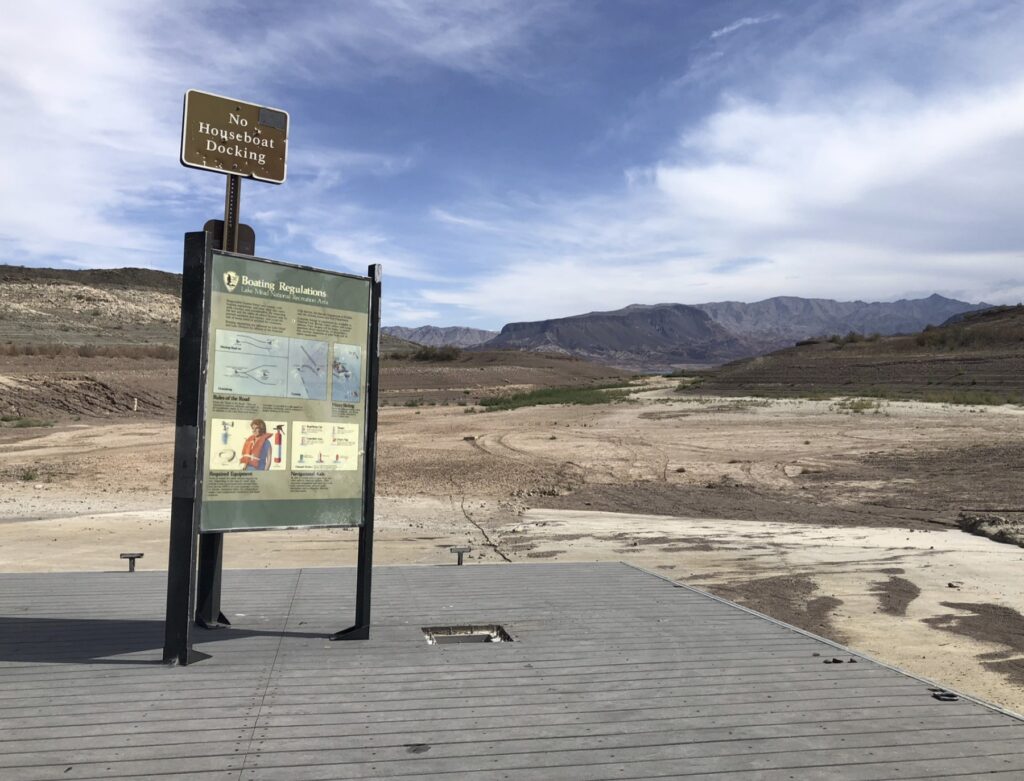Something remarkable is happening this year in the Lower Colorado River Basin that provides both a glimmer of hope about what durable basin solutions might look like, and also a clear demonstration of the obstacles still standing in their way.
Nevada’s Colorado River water use is on track to be the lowest it’s been since 1992
Southern Nevada’s projected 2023 use right now (the following is based on Reclamation’s Aug. 14 water forecast run) has dropped below 200,000 acre feet, sitting today at 199,943 af. That would be Nevada’s lowest take on the Colorado river since 1992. Southern Nevada’s population (Clark County, basically “greater Las Vegas”) has nearly tripled in that time.
Nevada has demonstrated its ability to take deep cuts without jeopardizing the structure and function of the communities that depend on Colorado River water.
Arizona’s Colorado River water use is on track to be the lowest it’s been since 1992
Arizona’s projected 2023 use, 1,974,819 acre feet, has dropped below 2 million acre feet, also the lowest since 1992. The Central Arizona Project, which supplies the Phoenix-Tucson area, is projected to take just 605,171 acre feet this year. That is 40 percent of CAP’s 21st-century average.
Arizona has demonstrated its ability to take deep cuts without jeopardizing the structure and function of the communities that depend on Colorado River water.
California’s Colorado River water use is on track to be the lowest it’s been since 2019
California’s use has dropped below 4 million acre feet, which would be the first time that’s happened since 2019, currently 10 percent below the state’s 21st century average.
Ok, the comparison is striking, right? Some states are doing a lot, other states are doing less. But I’m trying to be optimistic here, California’s water use reductions aren’t nothing! Everyone’s using less water!
But the relative depth of California’s cuts has not yet demonstrated its ability to take deep cuts without jeopardizing the structure and function of the communities that depend on Colorado River water.
The numbers
| State | Base allocation | 2023 | 2023 reduction | percent cut from base | 07/DCP | Cut beyond 07/DCP | |
| California | 4,400,000 | 3,997,677 | 402,323 | 9.1% | 0 | 9.1% | |
| Arizona | 2,800,000 | 1,974,819 | 825,181 | 29.5% | 592,000 | 8.3% | |
| Nevada | 300,000 | 199,943 | 100,057 | 33.4% | 17,000 | 27.7% | |
| Total | 7,500,000 | 6,172,439 | 1,327,561 | 17.7% | 609,000 | 9.6% | |
The Obstacles
The premise of a piece I wrote earlier this year in the New York Times is that there’s no way we can fix the Colorado River supply/use imbalance if California insists that the burden of overallocation and climate change fall on everyone else.
The new Schmidt/Yackulic/Kuhn paper puts the needed cuts at 20 percent just to stabilize the system – more if we’re going to rebuild a buffer against a repeat of last year’s shit show. Arizona and Nevada have figured out how to cut a lot more than that.
California, not so much.
A clarifying note on the picture
The above picture, which I took in October, no longer represents reality. Based on the latest Sentinel satellite imagery, a bit of water has returned to Boulder Harbor on Lake Mead’s western shore.


I worry about agricultural production in the Colorado River Basin. I’m assuming that what is grown is used. Some is exported from the US. Like alfalfa, grains, and meat. California is the largest foreign exporter by far. One approach on water allocation would be to look at reducing this business. But people producing these products would suffer financially.
Another direction is to improve irrigation. I see Utah fruit farmers are switching to drip irrigation. Could a Federal program to make this change across the basin be feasible?
And, ag producers could change crops to less water needed. Some of this will happen because changing temperatures will preclude some existing crops.
Has any overall analysis been done on these issues?
There are many ways which Ca can reduce their water use in agriculture. For one, they should switch to crops that can be grown in saline soil. A lot of the water that is used, is used to flush salts out of the soil so they can grow more lucrative crops. They will never stop unless they are made to. You also mentioned alfalfa, this is a water thirsty crop, and alfalfa is grown to be exported to Saudi Arabia. Saudi Arabia does not allow the growth of alfalfa in their country because of lack of water, however they have thousands of acres of fields of alfalfa growing in CA and AZ, using water from the Colorado River.
The last two posts I received from you were like this. Is it you or is it me?
b1=_F8HNgi5KP5JPvFhc2mwD8fuMCh2jHgVakjTJYbNbmyA
Content-Type: text/plain;
charset=UTF-8
Content-Transfer-Encoding: 8bit
X-Apple-Content-Length: 4579
–b1=_F8HNgi5KP5JPvFhc2mwD8fuMCh2jHgVakjTJYbNbmyA
Content-Type: text/html;
charset=UTF-8
Content-Transfer-Encoding: quoted-printable
X-Apple-Content-Length: 74608
–b1=_F8HNgi5KP5JPvFhc2mwD8fuMCh2jHgVakjTJYbNbmyA–
The last two posts I received from you were like this. Is it you or is it me?
b1=_F8HNgi5KP5JPvFhc2mwD8fuMCh2jHgVakjTJYbNbmyA
Content-Type: text/plain;
charset=UTF-8
Content-Transfer-Encoding: 8bit
X-Apple-Content-Length: 4579
–b1=_F8HNgi5KP5JPvFhc2mwD8fuMCh2jHgVakjTJYbNbmyA
Content-Type: text/html;
charset=UTF-8
Content-Transfer-Encoding: quoted-printable
X-Apple-Content-Length: 74608
–b1=_F8HNgi5KP5JPvFhc2mwD8fuMCh2jHgVakjTJYbNbmyA–